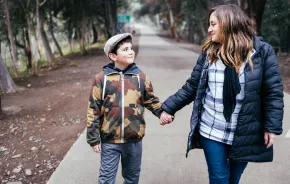 First, the good news. With the barrage of scary stories about cyberbullies, sexting and predators stalking teens on social media sites, here’s something you may not know: After years of teens living with social media, things may not be as bad out there as you think.
First, the good news. With the barrage of scary stories about cyberbullies, sexting and predators stalking teens on social media sites, here’s something you may not know: After years of teens living with social media, things may not be as bad out there as you think.
“People doing good, solid research on kids who use these powerful technologies find that, by and large, the kids are doing quite well,” says Mike Donlin, program supervisor for the School Safety Center at the Washington State Office of the Superintendent of Public Instruction.
“Young kids growing up with technology and all these toys don’t really distinguish between the brick-and-mortar world and the virtual world. They get up in the morning, brush their teeth and go online. Twenty-four/seven, things flow back and forth. Most kids are doing really well most of the time.”
The latest research from Common Sense Media’s Program for the Study of Children and Media found that 90 percent of teens have used social media, but a majority of the teens surveyed believe it’s a more positive than negative influence. Fifty-two percent say social networking helps their relationships with friends versus 4 percent who say it hurts those relationships.
However, as Internet safety expert Linda Criddle points out, the teen world of social networking is far from ideal. The biggest risk for kids who connect online is their own peers (cyberbullies, jealous boyfriends), not from online predators, says Criddle, president of iLookBothWays, The Human Factor in Online Safety.
She describes a typical scenario that starts with a harmless flirty text from a boy. Let’s say he texts, “I think you’re cute.” Things can go really wrong, really fast. Those text messages, endearing at first, can turn ominous if they persist, she says.
“You can’t hang out with friends without getting his text messages — which become intrusive, demanding and challenging. They begin keeping you up at night,” Criddle says. “Then you have to ask, when does this become abusive?”
Constant contact
The world in which teen couples hang out only after school and on weekends no longer exists, she says. Then, a jealous boyfriend might slump down in his car at his girlfriend’s house to catch her going out with someone else. Today, teens are in constant contact, and relationships progress at hyper-speed. “Technology facilitates new kinds of emotional or physical violence that weren’t possible before,” says Criddle, who emphasizes that all kids can be at risk.
Take “sexting.” According to the Cyberbullying Research Center, sexting is “the sending or receiving of sexually explicit or sexually suggestive images or video via a cell phone.” In a 2010 study of 4,400 students ages 11 to 18, the center found that 12.9 percent of them had received a naked or partially naked image of someone from their school, and 7.7 percent admitted to sending such pictures of themselves to someone else.
Criddle says the difference between texting and sexting is the amount of skin involved. “Safe sexting is a myth,” she says. “You either send a picture that puts you at risk or you don’t.”
Protecting teens
Can parents protect their teens from the problems and perils of social media?
They can try. The first step is to understand the online world and pay close attention to kids’ Internet habits. Filters, locks and passwords can give parents a false sense of security, experts say. And don’t encourage kids to break rules, such as signing onto Facebook before the eligible age.
Most of all, keep those conversations about safe and smart online behavior going. “It is so critical for parents to express their values around technology and values around safety, and keep talking about it,” says child safety educator Kim Estes, founder of Savvy Parents Safe Kids.
To avoid those inevitable eye rolls from tech-savvy teens, Donlin suggests asking them to explain social media to you. Say, “I don’t understand this sexting thing. Can you explain it?” Donlin says that approach worked with his kids. “I found out some things I didn’t necessarily want to know, but it was probably a good thing I did.”
Parents can also help their teens explore ways to set appropriate boundaries. For example, friends don’t ask friends for their passwords, Criddle says. “Teens have a hard time distinguishing between staying in touch and being tracked. Kids are sometimes overconfident; they have technical prowess, but are short on emotional prowess.”
That’s what Estes realized the night her 13-year-old daughter, Arden, announced that she had a boyfriend. He was from Michigan, and she’d met him on an online “chat roulette” site during a sleepover with friends.
After investigating, Estes was relieved to discover the “boyfriend” was a teen, not an adult predator. Her daughter was stunned that it took less than an hour to uncover his identity.
But Estes’ fears surfaced again soon after, when her daughter received a text from another stranger: “Hey, I’m in town. Let’s get together.” This time Arden came straight to her mom, who told her to respond, “Don’t ever contact me again.” She did — and he didn’t.
Estes learned a valuable lesson. “The greatest threat for kids is when parents start thinking, ‘Not my kid. My kid is very levelheaded, a rule follower, a sweet, adult-pleasing child,’” she says. “Stuff comes at you. Stuff comes at your kids.”
The key, safety experts say, is to start talking to your kids before something happens — and keep talking. Estes says she knew those discussions had made an impression on her daughter when Arden said this: “I just kept hearing your voice in my head.”
Elaine Bowers is a Seattle freelance writer.
Resources











